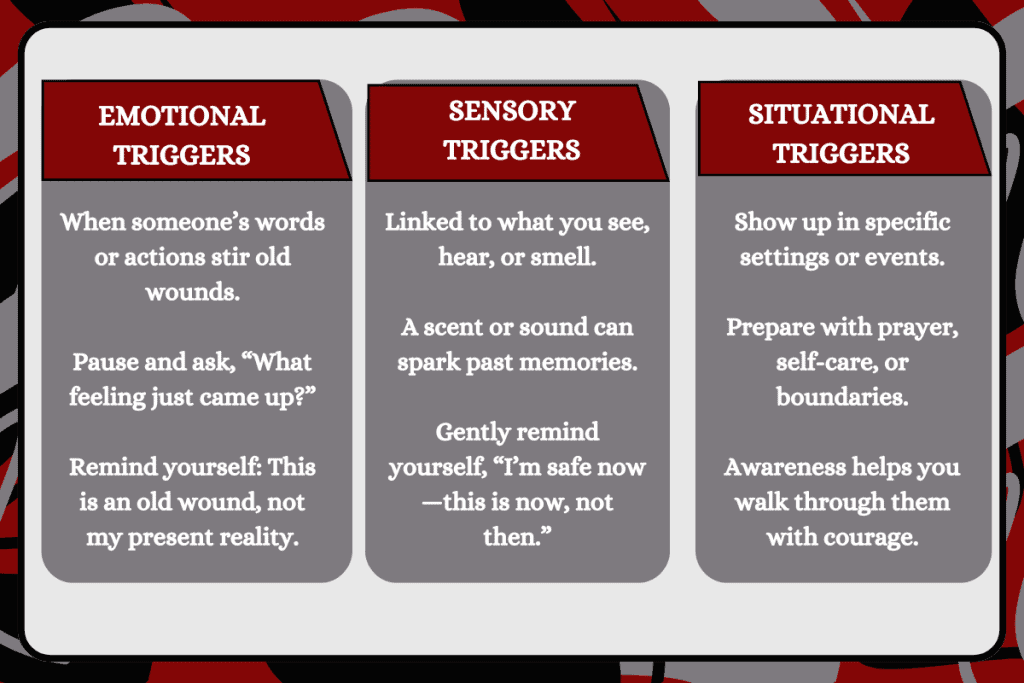Have you ever noticed how something small, like a sound, smell, or tone of voice, can suddenly make your heart race or your stomach drop? Maybe it’s a certain phrase someone says or a place that brings back a memory you didn’t expect. These moments can feel overwhelming, even when you can’t explain why. You’re not overreacting; your mind and body are responding to something deeper.
A trigger is anything that reminds your brain of a past painful or stressful experience, causing an emotional or physical reaction in the present. Triggers can appear out of nowhere and make you feel unsafe, anxious, or flooded with emotions. But the truth is, these reactions are your body’s way of trying to protect you, not punish you.
The good news is triggers don’t have to control your life. In this article, we’ll explore how to recognize what triggers you, regulate your body and emotions when they arise, and reset your mind and spirit with compassion and grace. Healing begins with awareness, and every moment you pause and breathe is a step closer to peace.
What Is a Trigger?
When we experience a trigger, our brain reacts as if an old wound has been touched. Even if the moment seems small, our nervous system can respond as if the original traumatic event were happening again. This happens because our brain stores emotional memories to protect us from future harm. When something feels familiar, a tone of voice, a look, or even a smell, it can trigger an emotional reaction, sending signals of danger even when we’re actually safe.
Think of it this way: your body is trying to help you survive, not overreact. The problem is, it doesn’t always know the difference between then and now. This is why you might notice your heart pounding, your breathing speeding up, or your thoughts racing during certain moments. These are your body’s natural fight, flight, freeze, or fawn responses, automatic reactions meant to keep you safe. For some, especially those who have experienced post-traumatic stress disorder (PTSD) or trauma triggers, these reactions can feel even stronger.
In these moments, grace becomes essential. You don’t need to judge yourself for being triggered. Instead, you can see it as your body’s way of saying, “Something here feels familiar, please slow down and care for me.” Using gentle coping strategies, like grounding, prayer, or exposure therapy, can help your nervous system feel calm again. When you meet those feelings with compassion and invite God’s peace into the moment, healing begins. Triggers don’t mean you’re weak; they show that your heart remembers, and with time and care, it can learn to rest again.
Common Types of Triggers
Triggers can show up in many forms, sometimes through what we see or hear, and other times through emotions or memories we didn’t expect. Understanding these triggers helps you recognize when your body and mind are reacting to a stimulus from the past, not the present. This awareness allows you to respond with calm instead of confusion. Let’s explore three common kinds of triggers: emotional, sensory, and situational.

1. Emotional Triggers
Emotional triggers happen when someone’s words or actions touch a sensitive part of your heart. You might feel hurt, rejected, or defensive without knowing why. These triggers often connect to past experiences where you felt unsafe, unloved, or unseen. For example, being ignored in a conversation might bring back memories of feeling invisible as a child.
When you notice emotional triggers, pause and check in with yourself. Ask, “What feeling just came up for me?” or “What am I afraid this moment means about me?” Taking a deep breath and reminding yourself, “This is an old wound, not my present reality,” helps you step back from the reaction. Over time, naming your feelings brings clarity, and with God’s help, you can respond from peace instead of pain.
2. Sensory Triggers
Sensory triggers are tied to your five senses, what you see, hear, smell, taste, or touch. A sound, scent, or texture can suddenly bring back memories of a traumatic event. For example, the smell of alcohol might remind someone of a loved one’s drinking problem, or a slammed door might make your body tense before you can think. These triggers may catch you off guard, but recognizing them helps reduce their power.
If this happens, gently remind yourself that you are safe now. Look around, notice your surroundings, and say quietly, “This is now, not then.” Using grounding techniques or faith-based coping strategies like prayer or deep breathing can help your nervous system reset. Over time, your mind learns that the trigger can cause discomfort without danger, allowing peace to return more easily.
3. Situational Triggers
Situational triggers happen in specific environments or circumstances. You might feel anxious before a big meeting, tense at family gatherings, or uneasy in crowded places. Sometimes, these situations include triggers that resemble moments when you once felt powerless or afraid. For instance, a disagreement at work might echo past experiences of conflict or rejection.
Preparing for these moments makes a difference. Set healthy boundaries, practice self-care, and pray for calm before entering stressful spaces. In therapy, approaches like EMDR can also help you process old memories that fuel these reactions. Remember, awareness doesn’t mean avoiding triggers, it means learning to walk through them with courage, grace, and understanding.
How to Recognize When You’re Triggered
Recognizing when you’re triggered is one of the most important steps toward healing. Often, triggers sneak up on us, one moment you feel fine, and the next, you’re flooded with emotion or discomfort. Maybe you suddenly feel tense in your body, anxious for no clear reason, or find yourself wanting to withdraw from a situation. These are your body’s quiet ways of saying, “Something doesn’t feel safe.” Learning to listen without judgment helps you cope with triggers in a healthy way and respond with care instead of criticism.
When you’re triggered, your body often reacts before your mind does. You might notice your heart beating faster, your stomach tightening, or your shoulders tensing. Some people experience strong physical sensations like feeling hot, shaky, or dizzy, while others go numb or disconnected. Emotionally, you might feel angry, scared, embarrassed, or shut down. Mentally, you may find it hard to focus or start replaying old memories or arguments in your head. These reactions are normal, your body is trying to protect you, not punish you.
Try to become curious about your responses instead of frustrated. When you notice changes in your body or emotions, take a slow breath and ask yourself, “What just happened?” or “What might my body be remembering right now?” Sometimes simply naming what you feel, like saying, “I feel anxious” or “I feel unsafe,” helps your brain start calming down. Remember, a trigger is something that signals your body to pay attention, it’s not a failure. Being triggered is a learning opportunity that can help you better understand your patterns and move toward peace.
How to Regulate Your Response
When you feel triggered, your body’s alarm system turns on, your heart races, your breathing changes, and your thoughts might spiral. The goal isn’t to push those feelings away but to help your body remember that you’re safe now. You can start by slowing down your breathing: inhale through your nose, exhale through your mouth, and notice your body begin to settle. Grounding yourself in the present moment also helps. Try naming five things you can see, four things you can touch, three things you can hear, two things you can smell, and one thing you can taste. These small steps gently tell your nervous system, “It’s okay to calm down.”
Faith can also play a powerful role in regulation. Saying a short prayer, repeating a comforting verse, or imagining yourself resting in God’s presence can bring peace to both your mind and body. When you feel emotions rise, pause and whisper something simple like, “Lord, help me find calm in this moment.” You can also take a walk, stretch, or talk with someone you trust. Over time, these calming practices retrain your body to respond with peace instead of panic. Remember, regulation doesn’t mean you won’t feel triggered, it means you’re learning how to care for yourself when you do.
How to Reset After Being Triggered
After a triggering moment, it’s important to give yourself time and space to reset. Once your body starts to calm down, take a few minutes to reflect. Ask yourself, “What just happened?” or “What emotion did I feel?” This helps you understand your reaction instead of judging it. Writing down your thoughts in a journal, taking a walk outside, or sitting quietly in prayer can also help you process what came up. These moments of reflection allow you to identify what triggers include for you personally, whether it’s certain words, tones, or memories. The goal isn’t to erase the feeling but to listen to what it’s trying to teach you. Healing happens little by little when you respond with curiosity instead of shame.
Resetting also means reconnecting with peace, mentally, emotionally, and spiritually. You might remind yourself, “That moment was hard, but I’m safe now,” or turn to Scripture that brings comfort, such as Philippians 4:7, which speaks about God’s peace guarding our hearts and minds. It’s okay if it takes time to feel grounded again; your nervous system is learning a new way to respond. Be gentle with yourself. You might be triggered again in the future, but each time you pause, breathe, and invite God’s presence in, you build resilience. Every small reset helps your body and spirit heal more deeply.
When to Seek Support
There’s no shame in needing help to understand or manage your triggers. Sometimes, the emotions that surface feel too heavy to handle alone. If your triggers start to interfere with daily life, causing anxiety, relationship conflict, or avoidance of certain places or people, it may be time to reach out for support. Talking with a mental health professional provides a safe and compassionate space to explore what’s behind your reactions without fear or judgment. Therapy can help you identify patterns, heal from past trauma, and discover new ways to respond with peace and clarity.
Faith can also play a vital role in your healing journey. You might pray for guidance in finding the right counselor or talk with a trusted pastor, mentor, or faith-based support group that aligns with your values. Remember, you can’t control the trigger fully, but you can learn to respond differently with the right support and tools. Healing doesn’t mean doing it all on your own, it means allowing others, and God, to walk beside you. Asking for help isn’t weakness; it’s courage in action. When you take that first step toward support, you’re saying, “I’m ready to heal.”
Final Thoughts
Healing from triggers isn’t about never being triggered again, it’s about learning how to care for yourself when those moments arise. Each time you pause, breathe, and notice what’s happening inside you, you’re building awareness and strength. It takes patience to unlearn old patterns, but every small step counts. Healing doesn’t happen all at once; it’s a journey that unfolds over time as you grow in understanding, compassion, and trust.
Remember, grace makes room for growth. You don’t have to have it all figured out to start healing, you just have to be willing to take one small step at a time. Invite God into your process and allow His peace to steady your heart. You are not defined by your triggers; you are defined by your courage to face them and your faith that healing is possible. As you continue forward, may you find calm in your body, clarity in your mind, and comfort in knowing that you are never alone on this journey.
Blessings,




